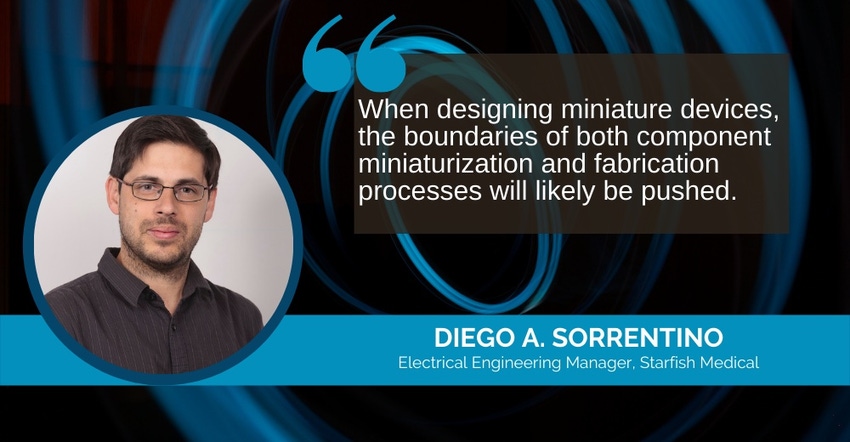An electrical engineer shares advice for working with small printed circuit boards for medical devices.
February 28, 2022

MD+DI asked Diego A. Sorrentino, M.A.Sc., P.Eng., who serves as Electrical Engineering Manager for StarFish Medical, to share best practices for designing miniature medical devices from an electrical engineering perspective. He offered the following three tips for medtech innovators working with small printed circuit boards (PCBs).
Spin a large form factor development board
One of the basic challenges of prototyping miniature products comes down to handling and interacting with them during the early development stages. This is particularly true when it comes to having to extract or inject signals into small printed circuit boards. In one opportunity, we had to design a kinematic data logging system to fit in one cubic centimeter of space. Passive components were barely visible to the naked eye. Parts needed to be so tightly packed that touching a single PCB trace with a scope probe was not feasible.
An obvious and yet sometimes overlooked solution to this challenge is to spin a larger form factor PCB that implements the same architecture as the intended miniature device. This allows the developer to break out more signals to aid the verification and troubleshooting of the design during early stages. Having a larger form factor prototype also allows for making corrections and repairs quickly without having to wait for a board re-spin.
Test critical components and fabrication processes early
When designing miniature devices, the boundaries of both component miniaturization and fabrication processes will likely be pushed. A good development strategy during the early prototyping phase is to use the critical components, PCB features, and fabrication processes intended for the final device. This is true even if spinning a large form factor prototype board. It is a good idea to populate it with the same parts that are intended for the end-design.
In our experience, and especially when pushing the boundaries of miniaturization, low PCB manufacturing yield is among the biggest challenges to overcome. Both the PCB design and the fabrication process parameters may require a few iterations until the yield attains acceptable levels. For example, special attention must be paid to component footprint design as it is not uncommon to run into problems due to improper wetting of the pads during fabrication. Other “advanced” PCB features like laser-drilled vias, if required by the design, may be worth prototyping from an early stage.
Consider Using Rigid-Flex PCBs for Medical Devices
When space is at a premium, electronic components may have to be fit in every corner available. Often, this can be achieved by means of housing multiple interconnected PCBs. Rigid-Flex PCBs offer a flexible (no pun intended!) and space-efficient way to interconnect circuits eliminating the need for cables and connectors. A flexible polymer to which a copper film can be adhered and etched is at the core of Rigid-Flex PCBs. Rigid sections are then constructed around this core using the usual rigid PCB materials like pre-impregnated and laminated fiberglass. Depending on the application, flexible regions may need to be bent a couple times during assembly or indefinitely during the life of the device. Typically, this last option will restrict the bend radius of the fold. Folds meant for multiple bendings will require larger bend radii (10’s of times larger) to avoid fracturing the attached copper foil.
About the Author(s)
You May Also Like


